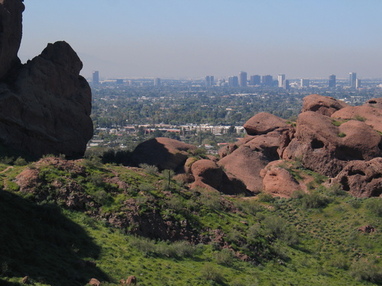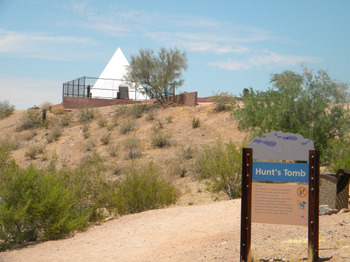Papago Park - Phoenix, AZ
Papago Park is situated in a city and region that probably should not be as heavily developed as it is. The Phoenix metropolitan area is located in in the heart of the southern Arizona desert. In the non-winter months the city is often characterized by nearly unbearable heat. The heat is often so extreme that it is unhealthy and dangerous for any human to be exposed to such high temperatures. The temperatures are combined with an extremely dry climate where measurable rainfall is very scarce. However, this has not prevented Phoenix from becoming one of the fastest growing regions in America. The metropolitan area spreads for miles upon miles in a rather low-density manner across the desert valley floor. The millions of people who now call the area home are almost completely dependent on air conditioning to maintain a respectable quality of life, which is a huge strain on energy. Furthermore, due to the warm weather, golf is an incredibly popular industry in the region. Therefore, huge amounts of water (which has already been established as extremely scarce) are used daily to upkeep the courses. In the end, much of Phoenix could be described as an artificially constructed landscape that is not entirely sustainable. However, parts of the city have been preserved and represent the Arizona desert as it would look like without massive human development. Papago Park is one such example.
|
Papago Park provides a large sanctuary of natural open space within the confines of the massively developed Phoenix area. It is a very large park that spans over 1200 acres and actually spills over into the neighboring city of Tempe, of which Phoenix shares operating responsibilities for the park. As the picture at the top of the text illustrates, it is a hilly park, which provides for great hiking opportunities as well as magnificent view of the metro region. The park is known for its ancient geologic formations, including red sandstone that were formed anywhere from 6 to 15 million years ago. It also a local showcase for a diversity of native desert plants that thrive in the untouched landscape of the park, including the famous saguaro cactus. The park also features numerous paths, an 18-hole golf course, the Desert Botanical Garden, several lakes, as well as Hunt's Tomb, the tomb of Arizona's first governor George W.P. Hunt, which is shaped in the form of a pyramid.
|
The area of the park has long been a site of local importance. The park has been everything from a Native American reservation in the late 1800s to a POW camp during World War II. It later became the site of a large VA hospital. Soon after WWII ended, the land was transferred to the city and it soon was preserved as valuable open space in an area that was markedly different than the reality of 2013. Development has completely encircled the edges of the park, which has made its preservation all the more valuable.
Phoenix is a city characterized by extremely hot and dry weather yet is dotted with green lawns and giant golf courses. It is simply not a natural design that fits with the harsh desert climate. However, there have been widespread and concerted efforts to reverse this trend by implementing landscape designs that are more ecologically suited to the region. Papago Park can provide a template for what untouched desert landscape can be. It is a very valuable resource for the region and improves the quality of life for residents and visitors alike, especially in the cooler months when the park can be fully experienced.
Phoenix is a city characterized by extremely hot and dry weather yet is dotted with green lawns and giant golf courses. It is simply not a natural design that fits with the harsh desert climate. However, there have been widespread and concerted efforts to reverse this trend by implementing landscape designs that are more ecologically suited to the region. Papago Park can provide a template for what untouched desert landscape can be. It is a very valuable resource for the region and improves the quality of life for residents and visitors alike, especially in the cooler months when the park can be fully experienced.



